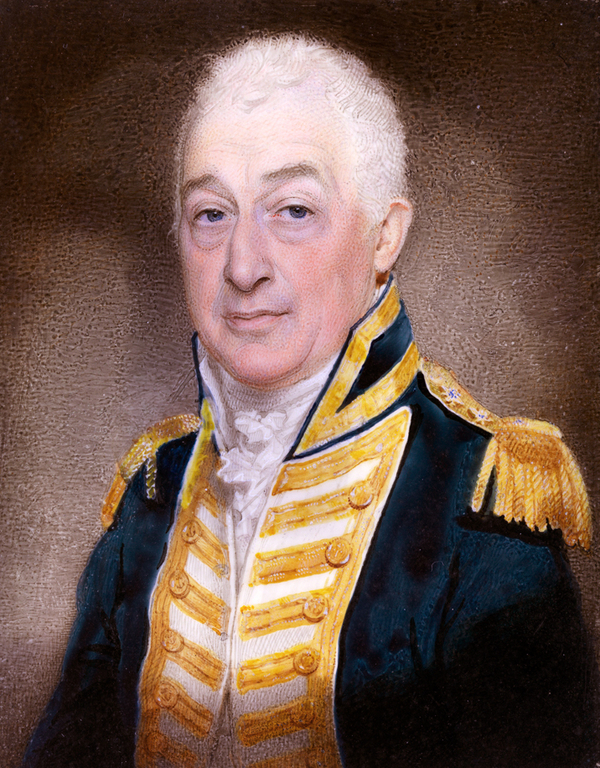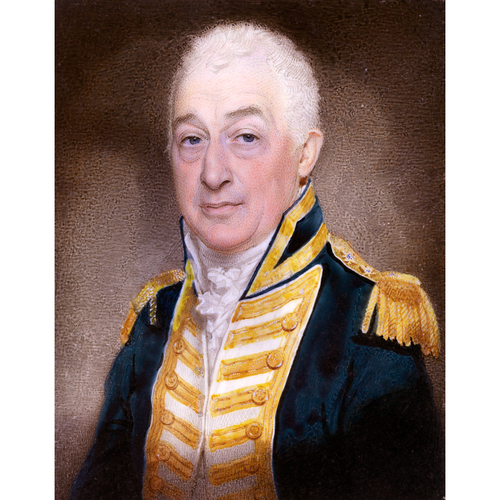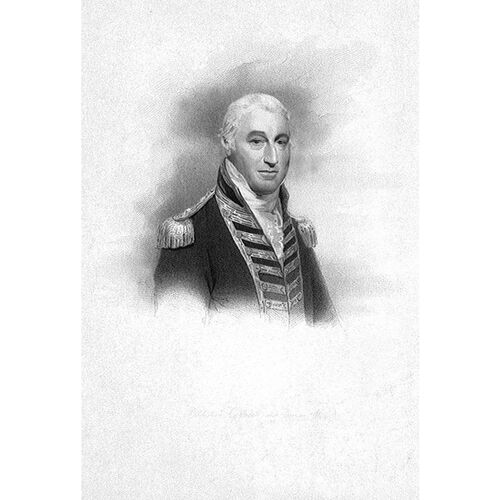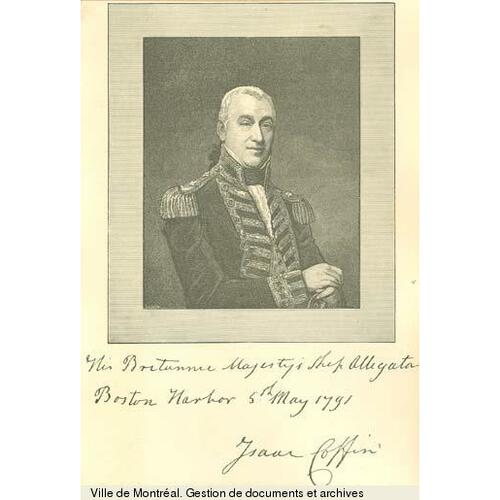
Source: Courtesy of Wikimedia Commons
COFFIN, Sir ISAAC, naval officer and seigneur; b. 16 May 1759 in Boston, Mass., son of Nathaniel Coffin, a customs officer, and Elizabeth Barnes; m. 3 April 1811 Elizabeth Browne Greenly and assumed the name and arms of Greenly for two years; d. 23 July 1839 in Cheltenham, England.
Isaac Coffin entered the British navy on the North American station as a volunteer in 1773 and was promoted lieutenant only three years later. He commanded the schooner Placentia off Newfoundland in 1778–79, survived a shipwreck in the armed vessel Pinson, also under his command, on the coast of Labrador late in 1779, and in 1781 was Rear-Admiral Mariot Arbuthnot*’s signal lieutenant on the Royal Oak during operations off Cape Henry, Va. On 3 July 1781 he received promotion to commander. In January 1782 he served as a volunteer under Sir Samuel Hood in a brilliant action off St Kitts, in the West Indies, and on 13 June of that year, through Hood’s influence, was made post captain, in command of the 74-gun Shrewsbury.
Coffin was evidently a capable young officer, and his subsequent career bore out the energy, competence, and bravery which won him early promotion. It also revealed an affinity for controversy. Within weeks of joining the Shrewsbury he refused to accept three unqualified midshipmen appointed to the ship as lieutenants by Admiral Lord Rodney, commander-in-chief in the West Indies. Brought before a court martial on 29 July 1782, Coffin was acquitted. In 1783 he was given command of a smaller ship, the Hydra, which he paid off in England before going on half pay.
In 1786 he returned to sea in command of the Thisbe, in which he took Lord Dorchester [Carleton*] to Canada. Two years later he was maliciously accused by its master of signing false musters. The practice was common but Coffin claimed he had made an honest mistake. The charge was nevertheless proved, and he was sentenced by a court martial to be dismissed from his ship. The first lord of the Admiralty, Lord Howe, changed the sentence to cashiering, and Coffin successfully appealed the punishment, which was pronounced illegal. Howe then reinstated Coffin because he “did not consider it advisable to exercise the right of the Admiralty arbitrarily to dismiss him from the navy.” The case established legal precedents concerning the limits of the Admiralty’s interference in sentences pronounced by courts martial .
In 1790 Coffin took command of the 20-gun Alligator, and in 1791 he brought Dorchester back to England, going on half pay again until the resumption of war in 1793, at which time he received command of the 36-gun Melampus. In 1794 he aggravated an injury he had acquired around 1790, when he jumped overboard to save the life of a seaman, and was never again fit for active service. He became regulating captain at Leith, Scotland, in 1795 and in October of that year went to Corsica as a civil commissioner of the navy. Evacuated to Lisbon when Corsica fell into French hands in 1796, he served there and in 1798 on Minorca. The following year he was appointed commissioner of the dockyard at Sheerness, England, but was sent instead to Halifax, where he became acting resident commissioner of the royal dockyard. The commissioner, Henry Duncan*, who was in England for medical treatment, took up Coffin’s post at Sheerness.
Admiral Lord St Vincent was to observe in 1800 that “nothing but a radical sweep of our dockyards can do any good, and that can only be accomplished in a peace.” By then, Coffin had already imposed some radical reforms on the Halifax dockyard. In December 1799 he had reported extensive irregularities: “a field was consequently opened for all kinds of frauds and embezzlements.” Coffin stopped warrant officers and seamen from collecting ships’ stores without supervision, removed the right of ships’ captains to issue orders to dockyard officers, began a monthly rather than quarterly issue of provisions and spirits in order to curb drunkenness, and insisted on adherence to Navy Board regulations in the repair and refit of ships He went on to pay off horses on the dockyard establishment (boats provided cheaper transportation), dismiss 50 labourers, survey the master attendant’s stores, and restrict landing or embarkation in the dockyard to those on official business. He capped off these measures by discharging the master shipwright, Elias Marshall, who had 48 years of service, 37 in the Halifax yard.
In April 1800 Coffin returned to England, bringing with him the evidence on which he had acted, so that it would not be “lost,” but Duncan and Admiral Sir William Parker, commander-in-chief at Halifax, reinstated some of those he had removed from office, including Marshall, “as the Public have suffered very little from his irregularity.” Coffin took up his post at Sheerness, where he applied himself with such efficiency and energy that he was brought back to the sea service (not normally allowed in the case of civil commissioners). He was promoted rear-admiral of the white on 23 April 1804. On 19 May he was made a baronet and became admiral superintendent at Portsmouth, a position he held until 28 April 1808, after which he had no further employment with the navy.
Promoted vice-admiral of the blue, Coffin continued to advance on the flag list until he became admiral of the blue on 4 June 1814. From 1818 to 1826 he sat as member of parliament for Ilchester. He was made a gch in 1832. His wife’s death, on 27 Jan. 1839, was followed by his own on 23 July of the same year.
In 1787 Coffin had alerted the Legislative Council of Quebec to American exploitation of the fisheries and to the existence of a flourishing illicit trade on the Îles de la Madeleine. A committee of the council, presided over by Chief Justice William Smith*, favoured Coffin’s solution, which was to become proprietor himself. The matter lay dormant until 1795, when Coffin raised it again with the Treasury in London. The Treasury having concluded that “the fishery at these islands, unless granted to an individual will remain waste and be used by Foreigners as well as the King’s subjects,” letters patent were issued to Coffin on 24 April 1798 for the seigneury of Îles-de-la-Madeleine. According to the terms of the grant, Coffin was obliged to allow free access to the beaches and shores for the fishery.
Because of Coffin’s professional abilities and his reputed knowledge of the fisheries, much “public utility” was expected to derive from his proprietorship. As an absentee landlord acting through agents he himself obtained nothing but aggravation. Like other proprietors in British North America of British origin, he wanted English-speaking settlers, but the islands offered them little. The Acadian inhabitants, who engaged in the walrus, seal, and cod fisheries, were reluctant to accept directions from Quebec rather than from Newfoundland as they had been accustomed to doing, and also resisted paying rent. After Coffin made his first and only visit to the islands in 1806, he tried in vain to have 22 families who had come from Saint-Pierre and Miquelon in 1792 with their priest, Jean-Baptiste Allain*, deported as “Frenchmen Enemies to the King who . . . live in open defiance of all law & carry on a contraband trade with the Americans to the great detriment of his Majesty’s subjects.” In 1822, having received no return on his investment, he attempted to sell or lease the islands to the United States. Two years later he wanted to settle friends and kin from Massachusetts, and in 1828 he proposed to annex the islands to Nova Scotia, to facilitate the administration of justice. None of these ideas was adopted.
The Îles-de-la-Madeleine venture failed, largely because the seigneurial system was in a state of flux and the British government, although prepared to admit Coffin’s claims, was out of sympathy with his cause. Lord Dalhousie [Ramsay] called it “a mad speculation.” After a visit to the islands in 1831 Lieutenant Frederick Henry Baddeley*, referring to criticisms of the Madelinots such as those made by Coffin, remarked that “smuggling, on these islands, is scarcely a breach of the law, for no law but the law of God is preached upon them. . . . As long as they are abandoned . . . to their own resources, it would be unjust to deprive them of the advantage which a free trade offers.” As a seigneur, motivated no doubt by instincts natural to a naval captain who was the son of a customs officer, Coffin had good intentions but no understanding of his tenants, and he left an archaic legacy to his heirs. His situation as seigneur was ironic, because he is remembered principally for the reforming zeal that marked his naval career.
NMM, C. G. Pitcairn-Jones, notes on sea officers. PAC, RG 1, L3L: 30884–85, 30892, 30906, 30913, 30922–35. PRO, ADM 1/494–95; ADM 12/22/443; ADM 106/2027–28; CO 42/123, 42/131, 42/192, 42/202, 42/221 (mfm. at PAC). F. H. Baddeley, “On the Magdalen Islands, being the substance of four reports,” Literary and Hist. Soc. of Quebec, Trans., 3 (1832–37): 128–90. Gentleman’s Magazine, January–June 1840: 205–6. [John Jervis, 1st] Earl of St Vincent, Letters of Admiral of the Fleet the Earl of St. Vincent whilst first lord of the Admiralty, 1801–1804 . . . , ed. D. B. Smith (2v., London, 1922–27). Ramsay, Dalhousie journals (Whitelaw), 1: 115–16. DNB. G.B., Admiralty, The commissioned sea officers of the Royal Navy, 1660–1815, [ed. D. B. Smith et al.] (3v., n.p., [1954]). Marshall, Royal naval biog., 1: 229. Paul Hubert, Les îles de la Madeleine et les Madelinots (Rimouski, Qué., 1926). Robert Rumilly, Les îles de la Madeleine (Montréal, 1941; réimpr. 1951). David Spinney, Rodney (London, 1969).
Cite This Article
W. A. B. Douglas, “COFFIN, Sir ISAAC,” in Dictionary of Canadian Biography, vol. 7, University of Toronto/Université Laval, 2003–, accessed January 5, 2026, https://www.biographi.ca/en/bio/coffin_isaac_7E.html.
The citation above shows the format for footnotes and endnotes according to the Chicago manual of style (16th edition). Information to be used in other citation formats:
| Permalink: | https://www.biographi.ca/en/bio/coffin_isaac_7E.html |
| Author of Article: | W. A. B. Douglas |
| Title of Article: | COFFIN, Sir ISAAC |
| Publication Name: | Dictionary of Canadian Biography, vol. 7 |
| Publisher: | University of Toronto/Université Laval |
| Year of publication: | 1988 |
| Year of revision: | 1988 |
| Access Date: | January 5, 2026 |





